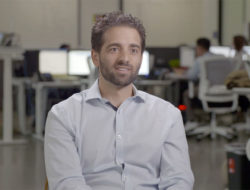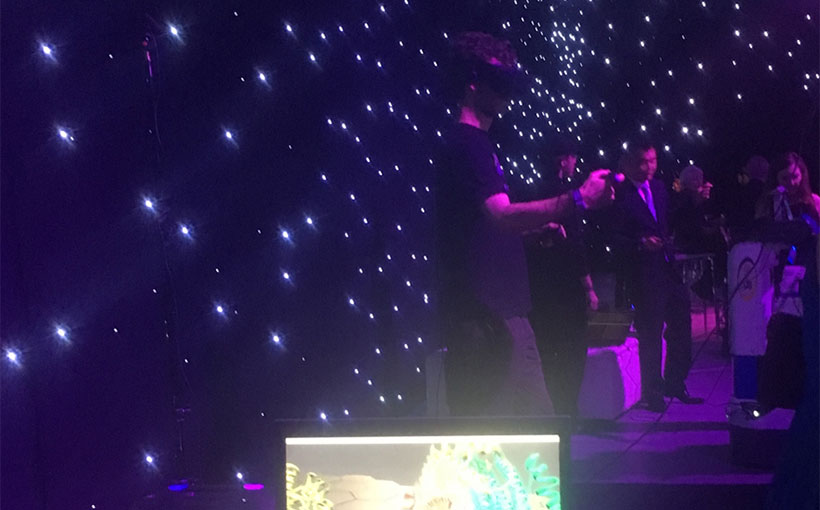Follow the Money
UCSD and Facebook alumnus Taner Halicioglu gave some momentum to UCSD’s ongoing $2 billion fundraising campaign with a $75 million donation to the university. It was showcased this weekend at a fundraising gala and it is the largest gift from a graduate in the university’s history. The money will be used to establish the Halicioglu Institute for Data Science. “This is one of my first times giving big money,” the 42-year-old said. “I’m giving something up, but getting something back. I want to do something transformative.” Halicioglu was one of Facebook’s earliest employees and is said to have built the initial hardware infrastructure for the social networking company. He is currently lecturing at UCSD and is a founding partner of Seed San Diego.
UCSD Showcases New Technology
At the UCSD event, I had a chance to see first-hand some of the new technology emerging from its research. I want to share with you two companies to watch and one important observation. The companies are below and the observation is this: After years of criticism, UCSD may have finally figured out tech transfer. I recently wrote about Ruben Flores Saaib, the new Director of Commercialization. He seemed to be focused on working to push more of the technology developed through research at UCSD into the commercialization. This weekend, Perry Teevens, CEO at Comhear, had nothing but glowing things to say about the tech transfer process for his company.
3D Audio Set to Transform Your Listening Experience
Last year I wrote about Ossic, an audio company transforming the way you listen to music and experience entertainment and gaming through 3D headphones. On Saturday night, I discovered the non-headphone version of Ossic. Comhear is rethinking the audio experience in a way that not only affects how you listen to music or audio entertainment, but also in terms of where you listen to it.
I sat in front of a sound bar that played music that I could hear perfectly in a room full of hundreds of people. CEO Perry Teevens shared with me some of the ways the technology has already been deployed. One of the most interesting is in an amusement park virtual reality experience. Each guest in the experience has a Comhear personal sound bar in front of them to create a virtual reality audio experience to match the visual experience. The technology places sound in proximity to you as you would hear it if it were real. If something moves or makes noise behind you, the technology beams that sound to the appropriate place for you to hear it behind you.
Comhear is in talks with automobile manufacturers to build a 3D system for cars that would not only enhance the entertainment experience, but also safety. And later this year, the company will launch a Kickstarter campaign to enter the B2C market. Individual audio sound bars will be available there for a limited time.
Comhear was developed at UCSD as part of the Qualcomm Institute, which is the UCSD division of the California Institute for Telecommunications and Information Technology. The goal is to bring students, faculty, researchers, and industry together to collaborate and build new technologies.
The company was named most innovative audio technology at this year’s Consumer Electronics Show and is starting to negotiate with gaming companies about integrating the technology. It is definitely a company to watch.
Nanome Creates Tool Valuable for Teaching and Pharmaceutical Industry
Nanome is a virtual reality platform that can be used for hands-on research, design, and simulation with nanoscale precision by scientists and engineers. If you are wondering what nanoscale is — here is a simple explanation: a nanometer is equal to one-billionth of a meter. When something is this small you cannot see it with the naked eye. You need a scanning probe microscope to see it.
The Nanome technology allows scientists to create a design — simulate the construction of proteins, for instance — using virtual reality with their hands. And then they can simulate what happens with that particular design. This would typically require scientists in a lab using expensive materials. Now it’s virtual.
The most interesting part of this technology is how varied its uses are. Calcflow was developed from it to create a course in vector calculus now offered at UCSD. Nano-One is the world’s first molecular drawing and modeling tool. And Nano-Pro can be tailored for a life science business to help reduce overhead and increase productivity.
With some help from an experienced board of advisors, the company’s executive team are all very recent graduates of UCSD. They are also looking ahead listing robotics and energy as areas where the technology might have an impact.
Be There or Be…
- Canopy San Diego Spring Cohort Launch Party
Wednesday, March 29, 5–8 p.m., Canopy San Diego, 6335 Ferris Square, Suite B - How to Make Networking Suck Less and Work Better
Thursday, April 20, 6–8 p.m. at WeWork, 600 B Street
Co-hosted by Dev Bootcamp and GeekGirl
Tags: Blogs, Comhear, Nanome, Startup Buzz, Startups, UCSD, Virtual Reality






























